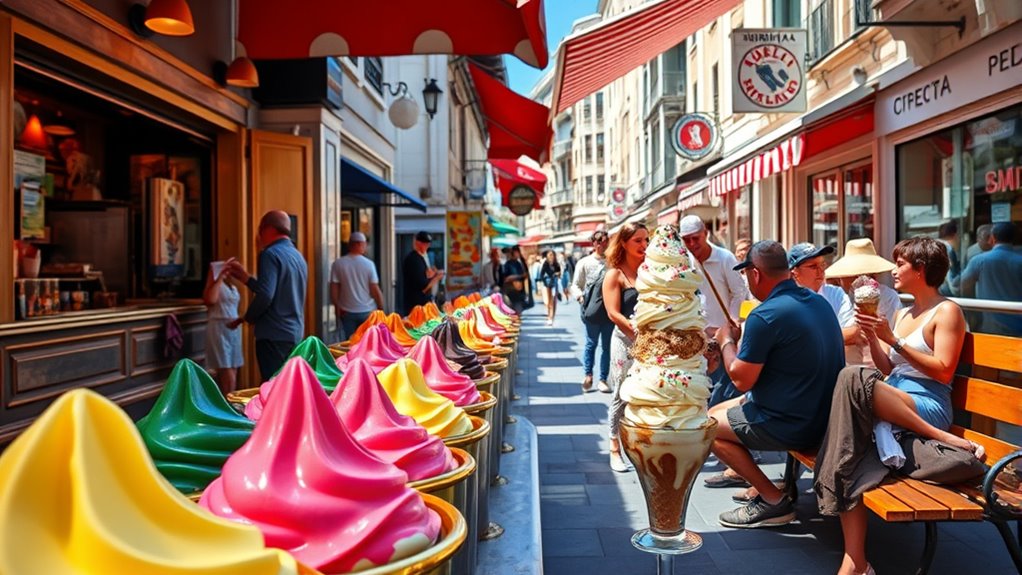In Italy, gelato reflects a deep focus on quality, natural ingredients, and craftsmanship, emphasizing pure flavors with less fat and air, creating a velvety texture. In contrast, American ice cream highlights variety, indulgence, and mass production, often using stabilizers and artificial flavors for a lighter, fluffier experience. These cultural differences shape each treat’s ingredients and production styles, offering distinct sensory pleasures. To discover how these traditions influence flavor and texture, keep exploring the unique worlds of gelato and ice cream.
Key Takeaways
- Italy’s gelato emphasizes high-quality, natural ingredients and traditional craftsmanship, highlighting flavor purity and dense, smooth textures.
- American ice cream is more diverse, often includes stabilizers and artificial flavors, and focuses on variety and indulgent, fluffy textures.
- Gelato’s lower fat content enhances flavor intensity, reflecting Italy’s appreciation for authentic, artisan production.
- US ice cream features higher fat and air content, resulting in lighter, more playful textures suited for mass appeal.
- Cultural values influence ingredient choices: Italy prioritizes quality and simplicity, while the US emphasizes innovation and broad accessibility.

When choosing between gelato and ice cream, understanding their key differences can help you make a better decision. One of the most noticeable distinctions lies in their texture differences. Gelato typically has a denser, creamier consistency that feels silkier on your palate, while ice cream tends to be lighter and fluffier. This difference comes from the way each is churned; gelato is churned at a slower speed, incorporating less air, which results in a richer, more velvety texture. Ice cream, on the other hand, is whipped more vigorously, leading to a higher volume of air that makes it feel lighter and more aerated. When you’re savoring gelato, you notice its smoothness and how it melts slowly, allowing you to really appreciate the flavor. Ice cream melts faster and can feel more invigorating, especially in warm weather.
Another key factor that sets these two frozen treats apart is ingredient variations. Gelato generally uses a higher proportion of milk and a lower amount of cream and eggs compared to ice cream. This shift in ingredients not only affects texture but also impacts flavor. Because gelato contains less fat, its flavors tend to be more intense and direct, allowing the natural ingredients like fruit, nuts, or chocolate to shine through. Ice cream’s higher cream and egg content create a richer, more indulgent taste, but sometimes mask subtler flavors. Additionally, gelato often relies on fresh, natural ingredients, and its production style emphasizes a more traditional, artisanal approach. Ice cream recipes, especially those mass-produced, may incorporate stabilizers and artificial flavors to extend shelf life and enhance consistency.
Culturally, Italy’s approach to gelato emphasizes quality ingredients and craftsmanship, resulting in a product that celebrates pure flavors and a smooth, dense texture. In the United States, ice cream has evolved into a versatile, accessible treat, with countless variations, from classic vanilla to inventive concoctions. The differences in ingredients and texture are reflections of each culture’s culinary priorities—Italy’s focus on quality and flavor purity, versus America’s love for variety and indulgence. When you’re choosing between the two, consider not just the flavor but also what experience you’re seeking: the intense, velvety richness of gelato or the lighter, more playful nature of American ice cream. Understanding these differences allows you to appreciate each for what it offers, whether you’re seeking a genuine taste of Italy or a fun, creamy American classic.
Frequently Asked Questions
How Do Traditional Italian Gelato Recipes Differ From American Ice Cream?
You’ll notice that traditional Italian gelato recipes differ from American ice cream mainly in ingredients differences and flavor profiles. Gelato uses more milk and less cream, resulting in a denser, silkier texture. It also relies on natural, intense flavors without artificial additives. In contrast, American ice cream often includes more cream and egg yolks, producing a richer, creamier consistency with a broader range of flavor profiles, including artificial ones.
Are There Regional Variations of Gelato Within Italy?
Yes, you’ll find regional variations of gelato throughout Italy. In Sicily, for example, you get flavors featuring local ingredients like pistachios and citrus. In Tuscany, chestnut or wine-infused gelatos are popular. Each region uses its unique local ingredients and seasonal flavors, reflecting local traditions and tastes. So, when you visit different areas, you’ll enjoy a variety of regional flavors that highlight Italy’s diverse culinary heritage.
What Are the Health Benefits of Gelato Compared to Ice Cream?
You’ll find gelato generally has fewer calories and fat, making it a healthier choice compared to ice cream. Many gelato shops offer low-fat options, helping you enjoy a sweet treat without guilt. Plus, some gelatos contain probiotic benefits from added yogurt or similar ingredients, promoting better digestion. Overall, gelato can be a more nutritious option, especially if you look for those with fewer fats and added health benefits.
How Do Serving Customs for Gelato and Ice Cream Vary Across Countries?
You’ll notice serving customs vary worldwide: in Italy, gelato is often served in small portions with a focus on quality, emphasizing proper serving etiquette. In contrast, the US tends to favor larger ice cream servings, especially in cones or sundaes. This difference reflects cultural attitudes toward indulgence and moderation. Whether you prefer a modest scoop or a generous serving, understanding these customs enhances your experience across different countries.
What Are the Environmental Impacts of Producing Gelato Versus Ice Cream?
You might notice that producing gelato often has a lower environmental impact than ice cream because it typically involves less energy consumption. Gelato makers who focus on sustainable sourcing use local ingredients, reducing transportation emissions. In contrast, ice cream production, especially on a larger scale, can require more energy and resources. By choosing options with sustainable sourcing and mindful energy use, you help minimize environmental impacts.
Conclusion
Now that you’ve explored the differences, it’s clear how culture shapes your favorite frozen treat. Did you know Italy consumes about 23 liters of gelato per person annually, compared to only 4 liters of ice cream in the US? This shows how deeply gelato is woven into Italian life. So, whether you prefer the rich, dense texture of gelato or the creamy variety of ice cream, understanding these cultural nuances makes every scoop more meaningful.









